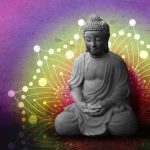Zen meditation is a very old and also well-known form of meditation technique that has been as old as Zen Buddhism when Buddhism entered Japan back in the 12th century. Zen Buddhism gained widespread popularity in the west during the 20th century, and so does Zen Meditation.
The Japanese word Zen’ (禪), an equivalent of Chán’ in Mandarin Chinese, is actually a Chinese transliteration of the Sanskrit word for “meditation”, dhyna, but the word “Zen” itself is now often associated with the peaceful, calming, relaxed, and serene feeling.
What Is Zen Meditation
Zen Meditation, also known as Zazen, is a meditation technique used by the Zen Buddhist monk to meditate on a daily basis.
Technique-wise, zen meditation is fairly simple: you sit with your legs crossed, or in the lotus position, and the goal of Zen meditation is to control your focus and attention. Zazen is famous for its motto, or rather, philosophy: “thinking about not thinking.”
Various studies and research have now identified three major categories of meditation techniques:
- Controlled focus: focusing on an object of meditation, which can be the practitioner’s breath, an image, or even an emotion.
- Open monitoring: actively monitor, or paying attention to internal and external experiences (i.e. sounds) without reacting or judging.
- Automatic self-transcending: not attempting to direct attention, but by training the practitioner can spontaneously transcend their own mental activity.
Zen meditation belongs to the open monitoring technique category, where the practitioner is actively using their monitoring skills to observe their own mind, as well as external stimuli.
With that being said, zen meditation is quite similar to mindfulness meditation, which is also widely popular in the West. However, while mindfulness focuses on holding and observing something in mind (to understand it very precisely), zen meditation instead focuses on giving up or dismissing anything in mind, focusing on the Zen philosophy that everything is already precise without effort.
Zen meditation, thus, does not focus on an object but keeps relaxing into the experience of dismissing thoughts. That is why: thinking about not thinking.

Benefits of Zen Meditation
Although the main focus of zen meditation is to relax one’s mind and improve your spiritual calmness, it can also produce various other benefits:
Relieving Insomnia and Improving Your Sleep Quality
Zen meditation can be a great solution to combat insomnia, and research has suggested that meditation can help you improve your conscious state to enter a sleeping state easily. According to the same research, studying the brain’s function during meditation, there are some similarities to the brain patterns during a zen meditation with the one we have during the hypnagogic (deep sleep) state.
Reducing Stress and Lowering Blood Pressure
A stressful mind, as we know, can also affect the body’s wellbeing, as our mind and body are deeply related to each other. Zen meditation can help you relieve stress, which in turn, can help your health and physical wellbeing. Zen meditation has been proven to increase the alpha and theta activity inside the brain, which will provide a relaxing mood. According to the same research, Zen Meditation can also prevent cognitive decline, which often happens when you are stressed.

Building Up Empathy
Another research indicated that there is an increase of empathy towards others in zen meditation practitioners. Doing Zen meditation on a daily basis can help increase your sense of empathy and tolerance, which, for example, can allow you to become a better team player in your workplace.
Anti-Aging
A core aspect of Zen Meditation is to maintain slow, regular breathing and keep it in tune with our minds. Research has suggested that low breathing frequencies in Zen Meditation can also lower the frequency of heart rate variability. Slower heart rate variability frequency will, in turn, reduce your heart degeneration, slowing your heart’s aging process.
Another journal suggested that Zen Meditation also has a neuroprotective effect and will help prevent cognitive decline that naturally happens as you age. This journal indicated that Zen Meditation can help preserve and rejuvenate your cells, even as you age more.
Do you want to learn more about Meditation? Check out our recommendations at “Meditation Bookshelf” and many free resources at our “Free MeditationLibrary“ – Opens in new tab
What’s The Right Posture For Zen Meditation
Zen Meditation is almost always performed by sitting. Unlike many other meditations, Zen Meditation emphasized how our body, breath, and mind are inseparable entities, and there are two main sitting postures that are usually used by Zen meditation practitioners: half-lotus and full-lotus.
- In the Full Lotus position, or Kekkafuza, each foot is placed on the opposite thigh. In Sanskrit, it is also known as padmsana, which is an ancient position in Yoga and Buddhism meditation.
- In half lotus (Hankafuza), one leg is bent and resting on the ground as you would in a normal cross-legged position. However, the other leg is bent with the foot forming a lotus position.
Half lotus is obviously easier than a full lotus position, so this posture is typically used by those who can’t (yet) handle the full lotus as their meditation posture.
The next thing to consider is your upper posture:
- Your back needs to be straight and centered (not bent to left or right).
- Keep your diaphragm relaxed, so you can maintain a deep, slow, and controllable breathing pattern.
- Try to “push” your buttocks outward and the hips forward. This can help to comfort your straight back
- Your neck should be straight and keep it still.
- Make sure your ears align with your shoulder, and your chin extrudes it forward.
- Make sure your nose is aligned with your navel.
Maintain this posture while keeping a relaxed feeling and try to be completely still throughout the Zen Meditation session. It’s not easy at first, but as usual, practice makes perfect.
Related reading: Guide to Different Types of Meditation Practices – Opens in new tab

How To Do Zen Meditation
There’s no one-size-fits-all approach to performing Zen Meditation, and if you ask different practitioners/teachers they might recommend different methods.
However, the basic principle remains the same, even if the end approach is totally different. In the end, feel free to chose a method that works for you, but here is our version of the Zen Meditation method:
- First things first, find an ideal place where you can properly focus. Make sure it’s spacious enough with a good temperature, and as far from noise and distraction as possible. Make sure the place has the right vibe to help enhance your meditation.
- Wear comfortable clothing. You should avoid heavy and/or tight clothing, as it can make you uncomfortable during meditation.
- Place your sitting mat (if any), then sit in a meditation posture that works for you. If possible, do some stretching to help relax your muscle and mind before assuming the sitting position.
- Assume a good posture for your upper body, as we’ve discussed above. Make sure you can hold the position in complete stillness as you start your meditation.
- Start to close your eyes and try to focus your mind. Make a mudra form with your hands (left hand rests towards your right hand), with the palms facing up and both your thumbs touching each other.
- Take a deep breath and maintain a slow breathing pattern. If your posture is correct, your diaphragm and belly can help you intake more air. The more oxygen you intake, the easier it will be to focus and empty your thoughts.
- As you maintain your slow breathing pattern, imaging your body, mind, and spirit are combined into one entity. Notice all things around you and all thoughts that materialize in your mind. Dismiss all stimuli and thoughts as soon as you notice them, and empty your mind again.
- Repeat this throughout the Zen Meditation until you can totally achieve the “thinking about not thinking” phase. Your mind not wandering, your body not moving, and you feel at ease as you enter a totally peaceful state.
- Try to do this for 10 minutes for your first session, then you can try a longer session as you are getting more comfortable doing Zen Meditation.
Zen Meditation VS Mindfulness
Both Zen Meditation and Mindfulness Meditation are rooted in Buddhism, and both are “open-monitoring” meditation methods.
The core difference between the two, however, is that Mindfulness Meditation is about observing your thoughts and external stimuli as detailed as possible, with the goal is to be aware of how precious each present moment is.
In Zen Meditation, however, it’s about dismissing thoughts and stimuli as soon as you notice them, with the goal is to empty your mind and keep a still composure. The Zen Meditation also focuses on finding a new perspective towards the natural worldview, attempting to aligning the body, mind, and spirit into one cohesive force.
Zen Meditation VS Vipassana
Vipassana, another popular meditation technique, is a controlled focus meditation, while Zen Meditation is open-monitoring meditation.
Meaning, in Vipassana the method revolves around focusing on an object of meditation, which can be various things such as our own breathing, an idea or image, and so on, with the goal is to attempt to direct or control the mind.
In Zen Meditation, on the other hand, the focus is to empty the mind by dismissing all thoughts and stimuli.
Do you want to learn more about Meditation? Check out our recommendations at “Meditation Bookshelf” and many free resources at our “Free MeditationLibrary“ – Opens in new tab
Stay in Touch
 Join our newsletter by using the forms on this website or click here!
Join our newsletter by using the forms on this website or click here! Follow us on Google News
Follow us on Google News Follow us on Facebook
Follow us on Facebook
Featured image from Depositphotos






